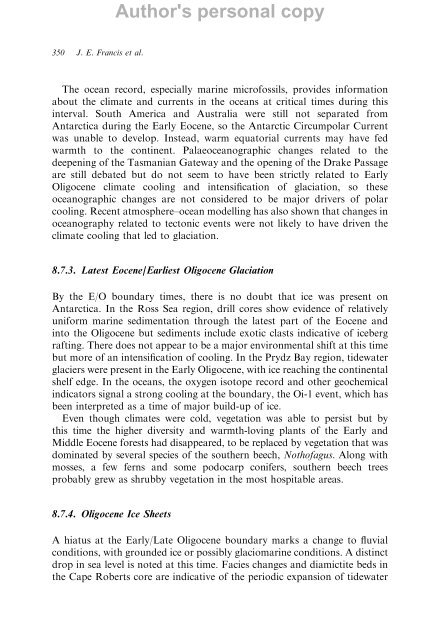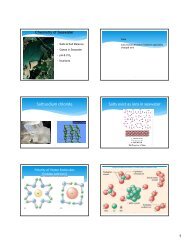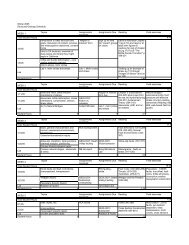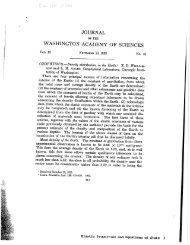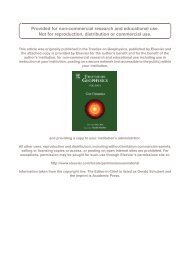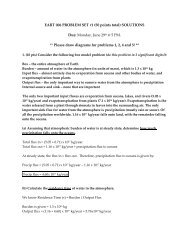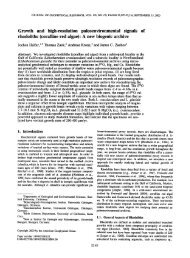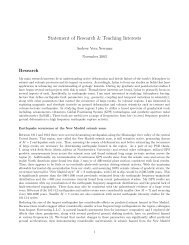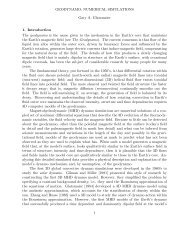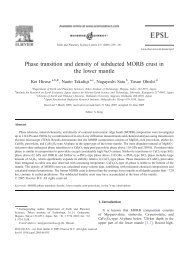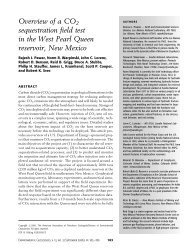From Greenhouse to Icehouse – The Eocene/Oligocene - UMass ...
From Greenhouse to Icehouse – The Eocene/Oligocene - UMass ...
From Greenhouse to Icehouse – The Eocene/Oligocene - UMass ...
You also want an ePaper? Increase the reach of your titles
YUMPU automatically turns print PDFs into web optimized ePapers that Google loves.
350 J. E. Francis et al.<br />
<strong>The</strong> ocean record, especially marine microfossils, provides information<br />
about the climate and currents in the oceans at critical times during this<br />
interval. South America and Australia were still not separated from<br />
Antarctica during the Early <strong>Eocene</strong>, so the Antarctic Circumpolar Current<br />
was unable <strong>to</strong> develop. Instead, warm equa<strong>to</strong>rial currents may have fed<br />
warmth <strong>to</strong> the continent. Palaeoceanographic changes related <strong>to</strong> the<br />
deepening of the Tasmanian Gateway and the opening of the Drake Passage<br />
are still debated but do not seem <strong>to</strong> have been strictly related <strong>to</strong> Early<br />
<strong>Oligocene</strong> climate cooling and intensification of glaciation, so these<br />
oceanographic changes are not considered <strong>to</strong> be major drivers of polar<br />
cooling. Recent atmosphere<strong>–</strong>ocean modelling has also shown that changes in<br />
oceanography related <strong>to</strong> tec<strong>to</strong>nic events were not likely <strong>to</strong> have driven the<br />
climate cooling that led <strong>to</strong> glaciation.<br />
8.7.3. Latest <strong>Eocene</strong>/Earliest <strong>Oligocene</strong> Glaciation<br />
By the E/O boundary times, there is no doubt that ice was present on<br />
Antarctica. In the Ross Sea region, drill cores show evidence of relatively<br />
uniform marine sedimentation through the latest part of the <strong>Eocene</strong> and<br />
in<strong>to</strong> the <strong>Oligocene</strong> but sediments include exotic clasts indicative of iceberg<br />
rafting. <strong>The</strong>re does not appear <strong>to</strong> be a major environmental shift at this time<br />
but more of an intensification of cooling. In the Prydz Bay region, tidewater<br />
glaciers were present in the Early <strong>Oligocene</strong>, with ice reaching the continental<br />
shelf edge. In the oceans, the oxygen iso<strong>to</strong>pe record and other geochemical<br />
indica<strong>to</strong>rs signal a strong cooling at the boundary, the Oi-1 event, which has<br />
been interpreted as a time of major build-up of ice.<br />
Even though climates were cold, vegetation was able <strong>to</strong> persist but by<br />
this time the higher diversity and warmth-loving plants of the Early and<br />
Middle <strong>Eocene</strong> forests had disappeared, <strong>to</strong> be replaced by vegetation that was<br />
dominated by several species of the southern beech, Nothofagus. Alongwith<br />
mosses, a few ferns and some podocarp conifers, southern beech trees<br />
probably grew as shrubby vegetation in the most hospitable areas.<br />
8.7.4. <strong>Oligocene</strong> Ice Sheets<br />
Author's personal copy<br />
A hiatus at the Early/Late <strong>Oligocene</strong> boundary marks a change <strong>to</strong> fluvial<br />
conditions, with grounded ice or possibly glaciomarine conditions. A distinct<br />
drop in sea level is noted at this time. Facies changes and diamictite beds in<br />
the Cape Roberts core are indicative of the periodic expansion of tidewater


